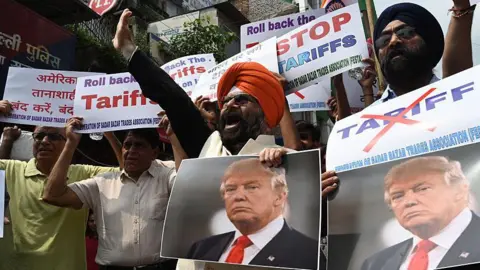In recent months, the bustling city of Lima, Peru's capital, has witnessed a chilling rise in gang violence, greatly affecting local businesses and community life. Jorge Tejada, a resident and owner of a recycling business, recently examined the remnants of a bus that was torched outside of his establishment, a clear act of retaliation by local gangs that have been terrorizing small businesses for refusing to comply with extortion demands.
Tejada, who is now 50, shared that he has lost track of numerous attacks on his neighborhood over the past year alone. Businesses ranging from bodegas to restaurants have been targeted, with some even resorting to hiding from the escalating threats. The death of a local pharmacist during a robbery serves as a grim reminder of the dangers lurking in previously safe areas.
"This used to be a tranquil area," Tejada lamented, noting how the once-vibrant community has transformed into a fearful environment riddled with violence. The alarming spike in extortion cases has left many citizens feeling helpless—statistics from national police indicate a staggering increase from hundreds to over 2,000 reports of extortion a month since 2017. Furthermore, the murder rate tied to hired assassins has risen drastically, mirroring the ongoing criminal crisis gripping various urban regions of the country.
As government officials scramble to address this growing epidemic, many Peruvians question whether safety and stability will ever return to their neighborhoods. The situation raises concerns regarding the effectiveness of law enforcement and the broader implications for societal well-being in a country already facing numerous challenges.
Tejada, who is now 50, shared that he has lost track of numerous attacks on his neighborhood over the past year alone. Businesses ranging from bodegas to restaurants have been targeted, with some even resorting to hiding from the escalating threats. The death of a local pharmacist during a robbery serves as a grim reminder of the dangers lurking in previously safe areas.
"This used to be a tranquil area," Tejada lamented, noting how the once-vibrant community has transformed into a fearful environment riddled with violence. The alarming spike in extortion cases has left many citizens feeling helpless—statistics from national police indicate a staggering increase from hundreds to over 2,000 reports of extortion a month since 2017. Furthermore, the murder rate tied to hired assassins has risen drastically, mirroring the ongoing criminal crisis gripping various urban regions of the country.
As government officials scramble to address this growing epidemic, many Peruvians question whether safety and stability will ever return to their neighborhoods. The situation raises concerns regarding the effectiveness of law enforcement and the broader implications for societal well-being in a country already facing numerous challenges.




















